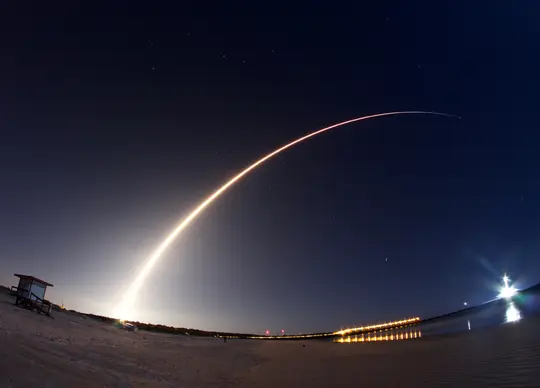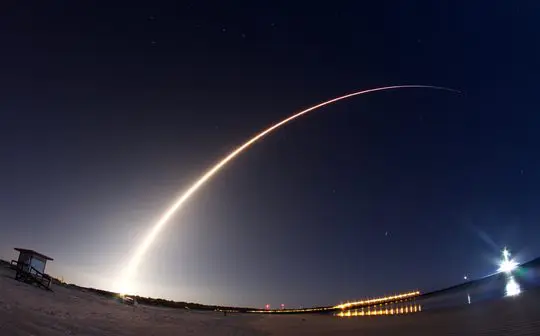
By Chris Flaherty.
INTRODUCTION
A recent statement from the South Korean Defense Ministry, called: “Space a ‘core’ area for building national security capabilities … [adding]… the country is building new launch sites and infrastructure” (Kim, 2022). Not all countries have pursued building a local Space-Launching ability. In the late 1960s, the United Kingdom developed its capability to launch the Black Arrow rocket from Woomera in Australia. Only to cancel the following year, after the UK Ministry of Defence decided to use the United States’ Scout rocket. This historically earned the reputation as the, “only nation to build a launch capability and then scrap it after the first launch” (Allison, 2022).
Sovereign Launch Strategy is primarily an outcome of two factors: (1) Global Position; the other, (2) Dependency.
SOVEREIGN LAUNCH STRATEGY AND GLOBAL POSITION
Sovereign Launch Strategy, is underpinned by a, “Sovereign Space-Launch Capability.” (Damp, 2021) What this actually means in terms of launch options varies, a variety of approaches are known. For instance, in the wake of the breakup of the Soviet Union, its key Land-Based Space Launching Facility: Baikonur Cosmodrome, fell into the newly formed Republic of Kazakhstan, requiring Roscosmos to enter into an ongoing leasing arrangement. Having lost its Sovereign Space-Launch Capability, Russia has actively pursued other options such as a Sea-Launching Capability.
The recent Russian announcement as to the renewal of the LP Odyssey, was made by the Deputy Prime Minister Yuri Borisov on the sidelines of the Army-2020 Forum (TASS, 2020). Russia’s renewal of the LP Odyssey was not linked to any military purpose; it is nevertheless likely to be in any countries’ national-strategic interests to have a Sea-Based Space-Launch Capability. Similar thinking, has been expressed by Chinese researchers, who have pursued a program looking at building a vessel similar to the LP Odyssey; reflecting the strategic notion:
breakthrough in Sea-Launch technology will enable China to launch medium and large satellites and constellations ‘both on land and sea’, especially into Low-Inclination Low-Earth Orbits … and it allows China to remain competitive in the fast-paced Space Industry.” (Song, 2020)
Private companies like SpaceX have actively pursued Sea-Based Space-Launching as a means to increase their launch options, as the Boca Chica site, due to land area limitations, environmental issues, and surrounding population density is sub-optimal compared to Cape Canaveral.
Largely seen as one of the optimal Space-Launch Facilities globally for Equatorial Launching, getting consignments in Earth Orbit, or sending a vehicle into the Solar System. Whereas, the European Union, in order to get the benefit of Equatorial Launch has relied on the Guiana Space Centre, which like Cape Canaveral, and Boca Chica, all share a common strategic position – open sea to the East.
The reason for this are two-fold, firstly under international safety practices, a Space rocket launch needs a clear path to fly-over as it leaves the Earth’s surface in case of a failure. Secondly, the Earth rotates Eastward on its axis, so launching a rocket towards the East gets an additional big boost from Earth’s rotational motion.
The exceptions to the rule, for Strategic Eastwards Launch, is operations at the United Kingdom’s premier Spaceport Cornwall (Newquay Airport) which effectively launches Westwards over the Irish Sea, as it is primarily specialising in Horizontal Air-Based Launching with services provided by the Virgin Orbit 747 launch aircraft. Cornwall’s runway design allows it the advantage for other Spaceplane landings, which will occur under the Sierra Space Dream Chaser Agreement.
Northwards, a line of major Spaceports are being developed for vertical launches in Scotland, and Norway (Andøya Spaceport). The strategic option is intended for Polar and Sun-Synchronous Orbits, which are best reached from a far-Northern latitude. Scotland, and Norway Spaceports have key safety advantage surrounded by the sea, allowing launches to take place over water, and sparsely populated areas.
In the Southern Hemisphere, the continental mass of Australia, presents another line of global optimal strategic launch options. Traditionally, the Eyre Peninsula, and Woomera in South Australia are seen as the best location to reach High-Inclination Orbits: An orbit of a Spacecraft that has a high tilted angle from the Equator, as well as the Polar Orbit market. The Eyre Peninsula launches fly Southwards over the Great Australian Bight, over water where there is no delicate marine environments and has minimal air and maritime traffic. While landwards, the flightpath is over coastline with very-low population occupation.
Baikonur Cosmodrome, like China’s Launch Facilities: Jiuquan, Taiyuan and Xichang, are all inland. The sites were originally chosen for qualities such as flat land (Taiyuan is surrounded by mountains), sparsely populated areas, and fair weather conditions.
More recently, issues such as settlement encroachments, continued use of toxic and highly polluting fuel being dumped down-course, poor weather, and in one location insect infestations, has detracted from the facilities’ attractiveness as optimal launch options. Australia’s inland Woomera site still retains the benefit of a safe launch option, as the area remains nil-to-sparsely populated.
DEPENDENCY
At the end of WW2, two countries: soon to be the World’s Superpowers were able to leverage captured German V2 rocket technology, to achieve reaching a new strategic frontier, the ability to circumnavigate the Earth with a Space vehicle. Having a Sovereign Space-Launch Capability was an historical accident that came about due to,
the military quest for ultra-long-range rockets that has provided man with new machinery so powerful that it can readily put satellites in orbit” (White House, 1958).
Space Dependency was a later development. As Space Launching Capability proliferated, countries began to develop Sovereign Space-Launch Capability. The United Kingdom example from the 1960s, is one well-documented case, where as a national strategy it opted for Dependency on the United States to meet its needs to get into Space, and this led to merging its Space Capabilities into first the European Common Market, and later the European Union.
The Brexit Era has seen a return to building in the United Kingdom several Sovereign Space-Launch Capabilities, spread over a number of Spaceports located on the British Isles.
Countries seeking to developed Space-Based Economies are sometimes locked into permanent Dependency relationships, with others that have Sovereign Space-Launch Capabilities. The Dependent country does not have the ability to build a rocket industry, or do not have access to an optimal geographical site to launch from. The recent debacle over Roscosmos’ withdrawing its role in international Space operations, brought about by sanctions, and counter-sanctions over the Russian invasion of Ukraine illustrates a key aspect of Dependency.
Ideally, due to its role in the International Space Station, and ongoing launch schedules, the strategic course should have been declaring Roscosmos having a ‘detente-status’ contained away from the conflict. Instead, a phony Space twitter war was declared, and the Roscosmos Director ordered ‘V’ and ‘Z’ symbols painted on various Baikonur Cosmodrome facilities, and on a rocket that was launched. The Roscosmos debacle emphasised a key vulnerability in current Space Launching Operations, namely Dependency on a particular launch option.
The Roscosmos debacle effected launch windows for OneWeb internet satellites, ExoMars rover mission, and several other European Space Agency planned missions.
Dependency relationships underpins the ‘working side’ of Space Launching Operations. Not all countries have Space rockets, launch facilities, or these are located in geographically far-off places. In the 1960s, the United Kingdom had to use Australia. Russia, is in a tenuous relationship with Kazakhstan, the European Union’s option is located in Guiana. Many countries are in commercial relationships with United States’ based companies. The United States’ connection also includes Rocket Lab’s operations in New Zealand, at its Mahia Launch Complex (Spaceport) on the East coast of the North Island.
FUTURE ISSUES
Sudden Space-Launch Industry growth, and proliferation of various proprietary rocket designs has led to configuration problems, where consignments are being designed for specific rocket types. To date, a variety of bespoke launch facility options, include the practice, where whole Spaceports are largely being built to service a particular rocket design. The commercial impetus is that the existence of a Spaceport is largely dictated by its exclusive commercial arrangements with a specific Launch Provider. However, political crisis, bad weather, and rocket malfunctions remain a bar to a successful launch schedule.
China and potentially Australia have the advantage of multiple launch options, spread over a large geographical area. China’s use of a suite of compatible launch vehicles can rapidly transfer consignments from one Launch Facility to another. The ability, ‘to outrun bad weather’ or move between various geographical positions has been the major driver of launch strategies based on using Sea-Based launching by Russia, China, and SpaceX developing floating ex-oil rigs as launching platforms; Black Arrow (United Kingdom) developing a ship launching platform; and South Korea’s use of a jack-up ex-oil rig as a launching platform.
Strategic pressure to find optimal Launch Points on the Earth’s surface, will lead to massive international competition, and countries with premium Land-Based options may have other countries place their Sovereign Space-Launch Capability there, if they want it or not.
AUTHOR
Chris Flaherty is a Space & Defense Tech and Security News Regular Contributor.
REFERENCES
- Allison, P.R. 2022 The UK could have space launch capability as soon as this summer. What will these spaceports look like and how will they operate? BBC.com (15 January).
- Damp, L. 2021 A Sovereign Space-Launch Capability is Crucial for Australia’s Prosperity and Security. ASPI Strategist.org.au (31 March).
- Kim, J. 2022 South Korea Tests Indigenous Solid-Fuel Rocket Week After North’s ICBM Launch. NK News.org (30 March).
- Song, Z. Xie, Z. Qiu, L. Xiang, D. Li, J. 2020 Prospects of Sea Launches for Chinese Cryogenic Liquid-Fueled Medium-Lift Launch Vehicles. Chinese Journal of Aeronautics
- TASS [Russian News Agency]. 2020 Sea Launch to be Restored at Cost of About $470 Million. Space Watch Global Website.
White House [The]. 1958 Introduction to Outer Space (26 March).





